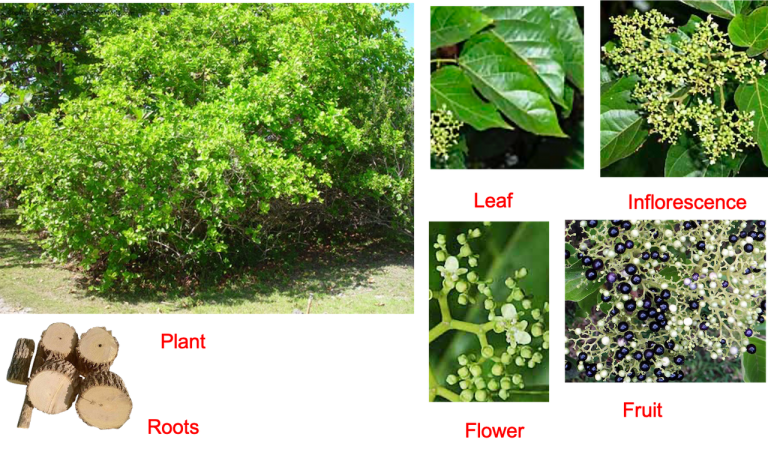AGNIMANTHA
- Home / DRAVYAGUNA (AYURVEDIC PHARMACOLOGY) / / KNOW ABOUT MEDICINAL PLANTS / / AYURVEDIC MEDICINAL PLANTS /
- AGNIMANTHA
The plant Agnimantha is an important plant in the field of Ayurveda. It is one of the plant that is present in the list of Dashamula. The fame of this group is very much that it is a name that every household in India is aware off. Thus being the most prominent plant of in Ayurveda its knowledge is very important for identification and use. Two species are usually considered under the name of Agnimantha. Some also take these two species as two varieties also. The botanical names of the plants are Clerodendrum phlomidis Linn. f. and Premna corymbosa (Burm f.) Rattler.
Among the two the first is known as Kshudra Agnimantha. The name Clerodendrum is obtained from two greek words namely Kleros and dendron which means ‘chance or fate’ and ‘tree’ respectively. The name phlomidis is derived from a greek word Phlomis which means ‘a flame’. Interestingly, the wood of the plant can generate fire by rubbing against each other.
The second variety is also known as Agnimantha. The word Premna is derived from the greek word ‘Premnon’ which means a stump or low stature of the species while the word ‘corymbosa‘ means a cluster in greek which mainly refers to the inflorescence of the plant.
PLANT DETAILS
BOTANICAL NAME
Clerodendrum phlomidis Linn. f.
Premna corymbosa (Burm f.) Rattler
FAMILY
Lamiaceae
NOMENCLATURE
VERNACULAR NAMES
- Kannada – Arani, Agnimantha
- Malayalam – Munja, Munnai
- Tamil – Thalnaji
- Telugu – Nelichett
- Hindi – Arani, Ganivar
- English – Wind Killer
SANSKRIT SYNONYMS
- अग्निमन्थ (Agnimantha) – when wood is rubbed against each other it produces fire
- जय (Jaya), जयन्ति(Jayanti) – Victory against diseases
- गणिकारिक (Ganikarika), आसवकारिक (Asavarika) – Grows in herds and promote health
- वातघ्नि (Vataghni) – Alleviates Vata Dosha
- नादेयी (Nadeyi) – seen on banks of rivers
- तर्कारी (Tarkari) – The leaves are edible and is used in making curry.
SAMHITA CLASSIFICATION
- Charaka Samhita – शोथहर (Shothahara), शीतप्रशमन (Sheetaprashamana) & अनुवासनोपग (Anuvasanopaga).
- Sushruta Samhita – दशमूल (Dashamula), बृहत्पञ्चमूल (Brihatpanchamula), वीरतर्वादि (Viratarvadi) & वरुणादि (Varunadi)
NIGHANTU CLASSIFICATION
- Dhanvantari Nighantu – Guduchyadi Varga, Panchapanchamula, Brihatpanchamula, Dashamula
- Bhavaprakasha Nighantu – Karpuradi Varga
- Raja Nighantu – Prabhadradi Varga
- Kaiyadeva Nighantu – Aushadhi Varga
BRIEF MORPHOLOGY
KSHUDRA AGNIMANTHA OR TARKARI – Clerodendrum phlomidis Linn f. –
A large shrub or small tree with numerous branches and smooth bark that grows upto 5 to 7 feet height. The leaves are dark green opposite, cordate, wavy toothed. Inflorescence is branched axillary cymes or terminal panicles with creamy white or pale yellowish flowers. Fruit is a drupe, wrinkled, obovoid, black with oblong white seeds.
AGNIMANTHA – Premna corymbosa (Burm f.) Rattler –
A shrubby tree that grows upto 25 to 30 feet height with a smoky coloured bark. The leaves are simple, opposite, soft or pubescent and ovate. The inflorescence is corymbose panicled cymes with bisexual small greenish white coloured flowers. Fruits are drupe, small equal to the size of coriander and purple in colour. The seeds are oblong.
PHARMACOGNOSY OF OFFICIAL PART
MACROSCOPY
YET TO BE COMPILED
MICROSCOPY
YET TO BE COMPILED
PART USED AND POSOLOGY
PART USED
मूल त्वक् (Root bark), मूल (root), पत्र (leaves) and त्वक् (Bark)
DOSE
क्वाथ (Decoction) – 10 to 15ml चूर्ण (powder) – 3-6g
PHYTOCHEMISTRY
Clerodendrum phlomidis Linn f. –
The root contains sitosterols, clerodin, clerosterol, ceryl alcohol, flavanoids, luteolin, etc. The leaves contain flavonoids, scutellarein and pectolinarin while the stems possesses glucosides, betasitosterol and ceryl alcohol.
Premna corymbosa (Burm f.) Rattler –
The leaves contain isoxazole, alkaloid premnazole, etc. The roots contain alkaloids, tannins, steroids, flavonoids, saponins, coumarins, triterpenoids, etc.
रसपञ्चक कर्म PROPERTIES AND USES AS PER AYURVEDA
गुण (Properties)
- रस (Rasa) – तिक्त (Tikta), कटु (Katu), कषाय (Kashaya), मधुर (Madhura)
- गुण (Guna) – रूक्ष (Ruksha), लघु (Laghu)
- वीर्य (Veerya) – उष्ण (Ushna)
- विपाक (Vipaka) – कटु (Katu)
- प्रभाव – None
कर्म & प्रयोग (Action & Indications)
- दोषकर्म (Doshakarma) – कफवातशामक (Kaphavatashamaka)
- धातुकर्म & मलकर्म (Dhatukarma and Malakarma) – Main actions – शोथहर, वेदनस्थापन, दीपन, अनुलोमन (Shothahara, Vedanasthapana, Deepana, Anulomana)
- Other Actions – कासहर, त्वच्य, रक्तशोधक, अर्शोघ्न, प्रमेहघ्न (Kasahara, Twachya, Raktashodhaka, Arshoghna, Pramehaghna)
- प्रयोग (Prayoga) – Mainly शोथ, वातव्याधि, पाण्डु, अग्निमान्द्य, विबन्ध (Shotha, Vatavyadhi, Pandu, Agnimandya, Vibandha), also useful in कास, प्रमेह, गुल्म, रक्तविकार, त्वक्विकार, शितपित्त (Kasa, Prameha, Gulma, Raktavikara, Twakvikara, Sheetapitta)
AYURVEDIC FORMULATIONS
CLASSICAL
- दशमूलारिष्ट
- दशमूलकटुत्रय कषाय
- दशमूलहरीतकि लेह
- अग्निमन्थादि लेप
- All Formulations where Dashamula is an ingredient.
PROPRIETARY
- All formulations where Dashamula is an ingredient.
AGRONOMY
ENVIRONMENT
Clerodendrum phlomidis Linn f.
This plant requires a laterite or red loamy soil especially with a tropical or subtropical climatic conditions.
Premna corymbosa (Burm f) Rattler
The plant requires a warm and humid climate along with a good drain of water. The soil is preferably a sandy and loamy with good organic content.
CULTIVATION
Clerodendrum phlomidis Linn f.
The propagation of the plant is with root suckers, seeds and stem cutting with semi-hardwood.
Premna corymbosa (Burm f) Rattler
The propagation of the plant is through stem cutting.
But the common practice is stem cutting in both the species. An average of 1000 cuttings can be planted in an acre of land. The irrigation in both the cases is once in 15 to 20 days during summer.
HARVESTING
Clerodendrum phlomidis Linn f.
The harvesting of the roots is done preferably after flowering which is usually after 18 months of planting. The average yield is 600 to 800 Kgs of dried roots per acre.
Premna corymbosa (Burm f) Rattler
The plant is left in the field for 3 years before harvesting for the roots. The approximate yield per acre is 500kgs of dried roots.
STORAGE
Clerodendrum phlomidis Linn f.
The roots on harvest is to be subjected to shade drying and stored in clean polybags. These bags are to be kept in a dry places.
Premna corymbosa (Burm f) Rattler
In this species, the root barks are peeled from the roots, dried in shade and stored in clean polybags. The bags containing these roots or root barks kept in dry places.
VARIETIES AND SUBSTITUTES OR ADULTERANTS
VARIETIES
The two varieties mentioned in the texts are अग्निमन्थ & तर्कारी (Agnimantha and Tarkari) where the former is regarded as Premna corymbosa (Burm f) Rattler and Clerodendrum phlomidis Linn f. respectively.
ADULTERANTS
NO KNOWN ADULTERANTS
SUBSTITUTES
No substitutes present
TOXICITY
TOXIC SYMPTOMS
- The plant is regarded as non-toxic
ANTIDOTE
- Not necessary
शोधन or PURIFICATION METHOD
- NOT NECESSARY
THERAPEUTIC USES
- The leaves of Agnimantha is given internally as a decoction to treat colic pain and flatulence.
- The leaves, stem and roots are given internally in the form of fresh juice or decoction to treat urinary complaints, diabetes and other urinary related disorders.
- Decoction of roots is given to treat urticaria and other skin diseases.
CONTROVERSY (IF PRESENT)
YET TO BE COMPILED
LIST OF RESEARCH STUDIES
- Rina H gokani, Nayana S Kapadia, Shah MB. Comparative pharmacognositc study of Clerodendrum phlomidis and Premna integrifolia. Journal of Natural Studies 2008;8(2):222-231.
- Susan RS, Harini A, Sunil Kumar KN, Hegde PL. Pharmacognostic and phytochemical analysis of Agnimantha (Premna corymbosa Rottl.) root. J Ayu Herb Med 2016;2(6):204-208.
The video on AGNIMANTHA emphasises on the various aspects of the plant especially with respect to its cultivation and its characteristics for identification such that they are preserved for the future generations.




